Excerpts from Jim Conrad's
Naturalist Newsletter
from the March 31, 2013 Newsletter issued from the Frio Canyon Nature Education Center in northern Uvalde County, southwestern Texas, on the southern border of the Edwards Plateau; elevation ~1750m (~5750 ft); N29.62°, W99.86°; USA
BARN SWALLOWS BUILDING A NEST
Barn Swallows overwinter from southern Mexico south throughout Central and South America. They showed up here several weeks ago and this week a couple began flitting past my computering window many times a day, and buzzing my head when I stepped outside the door. Below you can see one flying past the door with wings blurred, upper parts a solid cobalt-blue, tail deeply forked, and with a rusty throat and pale breast:
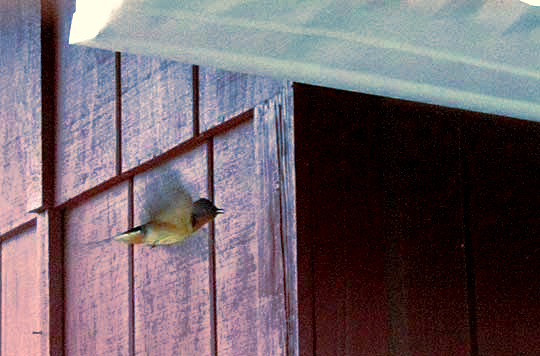
The swallows flew in and out from under the shed's eaves so it was easy to guess that they were building a nest there. I peeped up from below and saw what's shown below:

That nest is unfinished, the straw and plant roots forming the nest's interior not yet completely covered over with daubs of mud. My neighbor irrigates his big garden so during this time of extreme drought in our area mud was gathered where water pooled between the garden's planted ridges.
Roof eaves just as good as this one outside my door are available all through the valley, on vacant houses, on barns and sheds seldom visited by people, and even on my laundry shed's other side. However, this pair of swallows chose to build exactly where I enter and leave the cabin several times each day.
It was the same back during my hermit years in the forest near Natchez, Mississippi; animals who could have nested in so many places chose instead the very edge of my camp, and sometimes even beneath the roof where I made my campfires. I'm convinced that species such as the Barn Swallow often are attracted to spots with people moving about. Is it more because predators are less likely to come near my door, or because the birds are fascinated by human behavior? How much of their choice-making is like human thinking, and how much is mechanical?
Whatever the reasons, I'll be watching these swallows, and maybe have more stories and pictures later on.
from the June 9, 2013 Newsletter issued from the Frio Canyon Nature Education Center in northern Uvalde County, southwestern Texas, on the southern border of the Edwards Plateau; elevation ~1750m (~5750 ft); N29.62°, W99.86°; USA
BARN SWALLOW EGGS
A couple of Newsletters ago we looked at the Barn Swallow nest being built beneath the eaves of the laundry shed adjacent to the cabin. Nowadays the female is incubating her eggs. One day this week when she took a break -- and breaks can be frequent during our afternoons when the temperature stands in the mid 90s (±35C) -- I snapped the picture shown below:

I read that the Barn Swallow's clutch size usually is 3-7 eggs, and you can see that our nest contains six. Eggs average about 0.7 inch long (1.9cm), and the incubation lasts for 12-17 days. The AllAboutBirds.org website describes the eggs as creamy or pinkish white, spotted with brown, lavender, and gray, which applies to our eggs exactly. That website also says that both male and female build the nest cup using mud, which they collect in their bills and often mix with grass stems to make pellets. They first construct a small dried-mud shelf to sit on, then build up the nest's sides. The nest is first lined with grass, then feathers. Our Barn Swallows' nest thus appears to be exactly normal.
from the June 23, 2013 Newsletter issued from the Frio Canyon Nature Education Center in the valley of the Dry Frio River in northern Uvalde County, southwestern Texas, on the southern border of the Edwards Plateau; elevation ~1750m (~5750 ft); N29.62°, W99.86°; USA
BARN SWALLOW NESTLINGS
Now the nest has produced nestlings, and they're being fed. You can see the nestlings below:
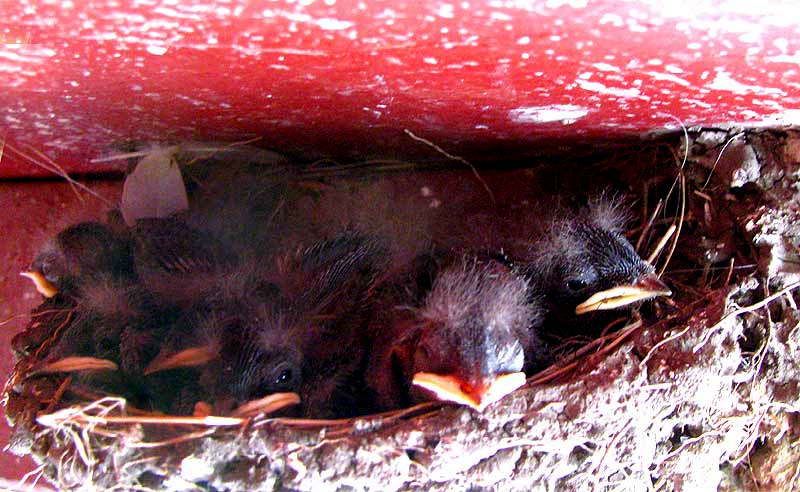
It looks six nestlings occupy the nest, and that's a big brood. The parents stay busy visiting the nest and don't seem to mind me except when I get close enough to take pictures like the one above, and then they fly near peeping urgently.
More than me, the parents really dislike the neighborhood Lesser Roadrunners, who range around the cabin like free-range chickens throughout the day. Even if the roadrunners are across the road the swallows swoop near their heads, peeping loudly, and the roadrunners look genuinely fearful of the little birds.

from the the June 3, 2012 Newsletter, issued from near Natchez, Mississippi, USA:
BARN SWALLOW FLEDGLING
Beneath a small, seldom-used, concrete bridge over a currently dry stream I went to check on some Barn Swallow nests I've been watching. They were mud nests in the bridge's darkest corners, as shown below:
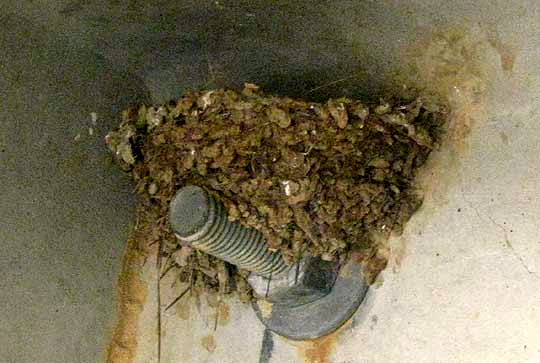 .
.The four or five nests had been abandoned since my last visit. As I wondered how the nestlings had fared, an adult Barn Swallow streaked beneath the bridge, right beside me, then soared back into the sky, but not before I'd noticed a fluttering on the gravel a few feet out from under the bridge. It was a swallow fledgling, and I bet the adult who'd just streaked by was watching it, and not happy about my messing around there. Before quickly leaving the area I snapped the fledgling's picture, shown at the top of this page.
There you can see the bluish sheen already appearing on the bird's back, the deeply forked tail, and the tawny throat on its way to becoming dark orange -- all features distinguishing Barn Swallows from other swallow species possibly found in this area. Another shot from the front showing that the bird is so young that it still retains the "white lips" helping make the mouth a target when an adult arrives with food to plop into it is shown below:
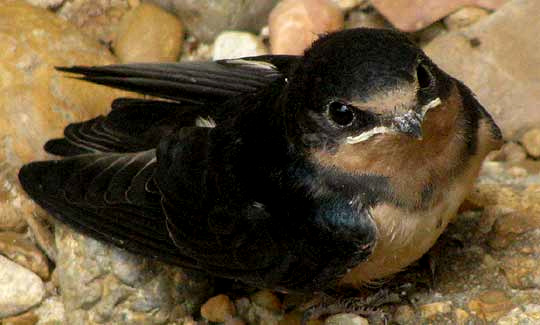
The fledgling must have just left the nest, for it couldn't fly at all, just flutter along the ground like an injured moth. From up on the bridge I watched it try to mount a foot-high tree branch fallen onto the ground, but it couldn't. Finally it pulled itself into some weeds where it hid itself completely. All during this time several Barn Swallows flew gracefully far overhead, round and round, so I knew I was being watched, and left.
Barn Swallows are summer residents here. They might be confused with Cliff Swallows, but that species' tails are squared, not deeply forked. Rough-winged and Bank Swallows lack the bluish tinge. Tree Swallows don't nest this far south and have white throats.
Barn Swallows overwinter from central Mexico all the way south to the southern tip of South America.
issued June 26, 2021 from the Dry Frio River Valley in northern Uvalde County, southwestern Texas, on the southern border of the Edwards Plateau, USA
MUD NEST
High at the crest of Fred's two-story house the mud nest shown below is one of several that this season have produced nestling:
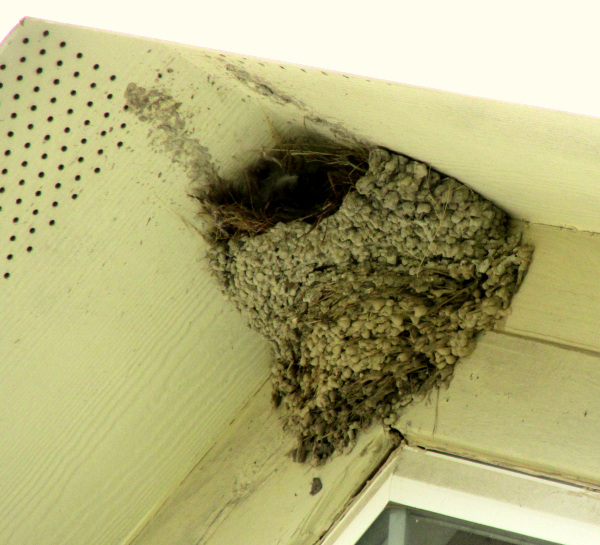
issued September 11, 2020 from the Dry Frio River Valley in northern Uvalde County, southwestern Texas, on the southern border of the Edwards Plateau, USA
JUVENILES ON POWER LINE
In mid morning twenty birds, mostly juveniles, perch in a neat row along the power live across the Dry Frio River, scratching, preening and generally flitting around, as shown below.
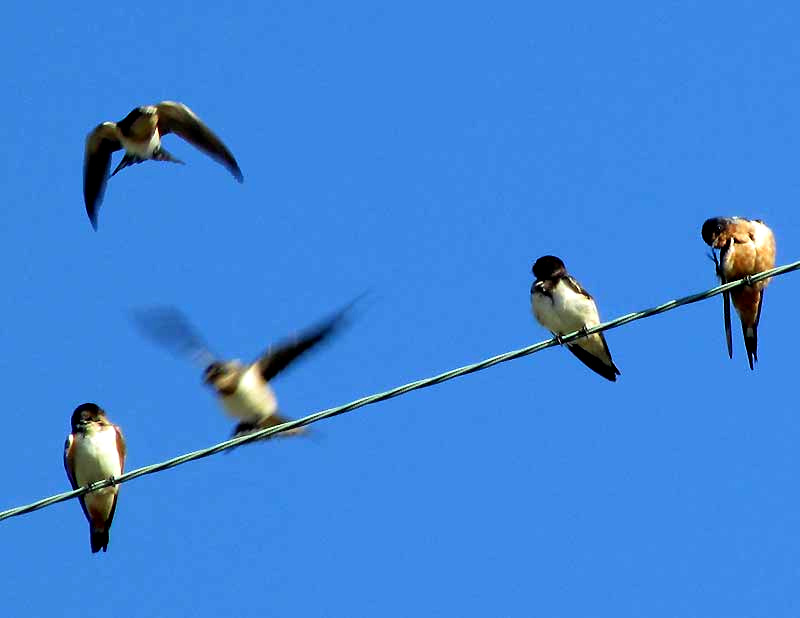
from the July 20, 2003 Newsletter, issued from near Natchez, Mississippi, USA:
BARN SWALLOWS ON POWER LINES
For the last month I've enjoyed watching a flock of 15-20 Barn Swallows, HIRUNDO RUSTICA, who alternately fly over the big field next to the barn, and rest on the power lines between the field and the highway.
I love these birds' playfulness. In the sky it's obvious that sometimes they forgo their insect- catching for a few moments and play something like bird-tag, chasing one another through deep dives and close maneuvers. The telephone line running to the barn is strung so low and loose that it sways a lot. Young swallows take special pleasure in perching on that wire, apparently because it's so much fun trying to keep one's balance. The birds tip forward, catch themselves with a flutter, then fall backward and flutter again, then a leg slips, then another tip forward, etc., on and on. One afternoon an Eastern Kingbird chased them all away, landed on the wire himself and played the game, then, gradually, one by one, the young swallows returned and landed a distance from him, and for several minutes they all played on the crazily snaky line.
Some bird species seem almost mechanical, but if you watch an individual Barn Swallow long enough you'll decide that it has its own nature or mood. It's especially hilarious when the parent is beginning to think that the young are old enough to be feeding themselves, but the young are perfectly happy to have food plopped into their mouths. Harried, exhausted, almost sulking, stand-offish adults with too many playfully beseeching, eternally pestering, demanding kids, as in millions of households among thousands of species...
A few Barn Swallows spend their winters along the US Gulf Coast, but most go on into Central and South America.
from the March 10, 2008 Newsletter, issued from the Yucatan's northwestern coast, Mexico:
YOUR BARN SWALLOWS ARE HEADING NORTH
This week as I walked beside the mangrove swamp next to Hotel Reef I saw lots of Barn Swallows, all of them flying eastward along the coast, against a stiff wind. For a couple of hours swallows were seldom out of my sight, though there was never many of them, usually no more than four or five. This is highly significant, for Barn swallows do not overwinter in the Yucatan. This is the first time I've seen them this winter. They were migrating north, preparing to make the great leap across the Gulf of Mexico onto the coasts of Louisiana, Alabama, Mississippi...
Barn Swallows do overwinter from a bit south of us to Tierra del Fuego, so the swallows I saw may have flown only from Guatemala or Chiapas. Still, they were the harbingers of a majestic event, spring bird migration, and as I stood in all that wind, sunlight and dry heat amidst gyrating coconut palms and the thunder of the ocean surf not far away, I couldn't keep from remembering all the times I've documented and celebrated these birds' arrivals up north.
When I was a kid in Kentucky one March morning I entered Earl Bryant's old abandoned farmhouse and found a dozen or so dead Barn Swallows scattered on the wooden floor. They'd entered through a broken window and died during a hard freeze the night before. I remember standing there trying to imagine what it must have been like where they'd come from if they couldn't survive the coldness our native winter birds hadn't had any trouble with. Now, at the other end of my life, I'm at the other end of the migratory route, and I am wishing these swallows well as they head north.
Spring is coming... but of course it's the rainy season that's coming... yet what a thing to be split in so many ways, to be me in Earl Bryant's old farmhouse the morning after the terrible swallow-killing freeze, and to still be me here among the teeming mangroves, watching swallows depart for the North.
from the July 20, 2006 Newsletter, issued from Polly's Bend, Garrard County, in Kentucky's Bluegrass Region:
BARN SWALLOWS IN FLIGHT
As I biked home the other day a flock of maybe a dozen Barn Swallows circled above the pasture downslope from the road, just beyond the power line. Their excited twittering caused me to look over just in time to see something wonderful: Suddenly two birds broke from their seemingly random, uncoordinated circling, flew toward one another, right before meeting they both arced their flight upward, and then their beaks touched in midair. Instantly they broke away from one another and in half a second lost themselves once more in the general circling.
I'd seen an adult feeding a fledgling.
I wasn't surprised to see this, for Barn Swallows can even mate in flight, and you've probably seen them skimming the water's surface drinking. These birds are sublimely adapted for life on the wing.
Seeing this here in the lush, humid, super-green Kentucky countryside sent me back to that day not long ago described in this year's March 25th Newsletter when I stood "in all that wind, sunlight and dry heat amidst gyrating coconut palms and the thunder of the ocean surf not far away" seeing great numbers of migrating Barn Swallows on the northern Yucatan coast. They were about to make the great leap across the Gulf of Mexico to the Alabama, Mississippi and Louisiana coasts, and I worried that with all that day's wind surely many wouldn't make it.
But, now I'm sure that a lot did make it, and before long the fledgling I just saw receive a meal from its parent would be returning south to overwinter. How satisfying amidst all of today's destruction and misery to witness an event happening exactly as it should, when it should, for no motives other than that it is natural that it should be so.
from the March 10, 2008 Newsletter, issued from Mexico's southernmost state, Chiapas:
BARN SWALLOWS AT DUSK
Here any day you can see Tree Swallows swooping about, sometimes 15 or 20 in a disperse flock and sometimes excitedly calling to one another chrip, chrip, chrip... This week, and not previously since I've been here, about an hour before dusk the Tree Swallows' usual last-minute foraging was augmented by large numbers of Barn Swallows. At any one time you might see ten to twenty Barn Swallows occasionally swooping for bugs but in general they're all heading toward the west.
Is this spring migration? Barn Swallows are only winter visitors here, overwintering from central Mexico to the southern tip of South America. Flying westward here means flying up Chipas's Central Valley to where it's not far from the Pacific coast. Are these birds following the coast to California?
Howell writes: "Winter movements need study." So maybe these notes will someday help someone figure out how our pre-dusk flights fit into the broader scheme of things.